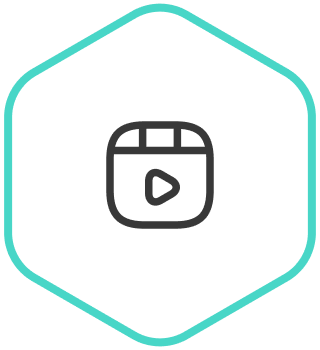Unbiased Hiring
What does an unbiased screening process look like?
Our partner, Applied, a diversity led recruitment software, outlines the steps that companies need to take in order to create an unbiased screening process, including how to remove unconscious bias.
You need to hire someone - you’ll get hundreds of applicants, and at some point, you’ll need to decide which ones you’re going to interview.
So what do you do? Well, most businesses will glance through a CV, and make a careful judgement - based on education, previous experience and job titles - about whether or not they can do the job.
Or do they? What other things might be influencing their decision on who to interview? And while we’re on it, do these things we just described even predict whether they’ll be any good at the job?
According to the research, the answer to both those questions is no.
What is Unconscious Bias
The human brain makes decisions in two ways. System 1 & System 2 (Kahneman).
System 1 is intuitive, emotional and instant. It’s how you know that 2+2 = 4, that if something is flying towards your face you should move and that people dressed as bus conductors are probably bus conductors
System 2 is the logical slow part of the brain. It works things out - What is the best way to tackle this problem at work?, was Milton or Dante a better poet? What is 3453+1023?
System 2 isn’t good, and System 1 isn’t bad. System 1 lets us function in the world. If we had to work everything out consciously and deliberately we would be paralized by the overabundance of evaluative decisions. However System 1 can be bad when it interferes with decisions that should be made thoughtfully rather than instinctively.
These mental shortcuts are collectively what we call “unconscious bias”, and to repeat they are not inherently bad - without them you really wouldn’t get anything done; but they can lead us astray. Here is an example
Availability heuristic — When trying to decide how likely certain events are, we are heavily influenced by the ease with which these events come to mind. This is why we might think that winning the lottery is more likely than being crushed by a meteor or giving birth to identical quadruplets. Even though those things are actually more likely we can all think of a news story where someone has won the lottery more easily.
Lot’s more examples here.
Back to recruitment: there are a lot of unconscious biases that interfere when we make snap-decisions about candidates in just 7 seconds (the average amount of time people look at CV’s). However weighing up job applications is exactly when we should be using System 2 (thoughtful & logical) rather than System 1 (intuitive). See some examples in picture 1
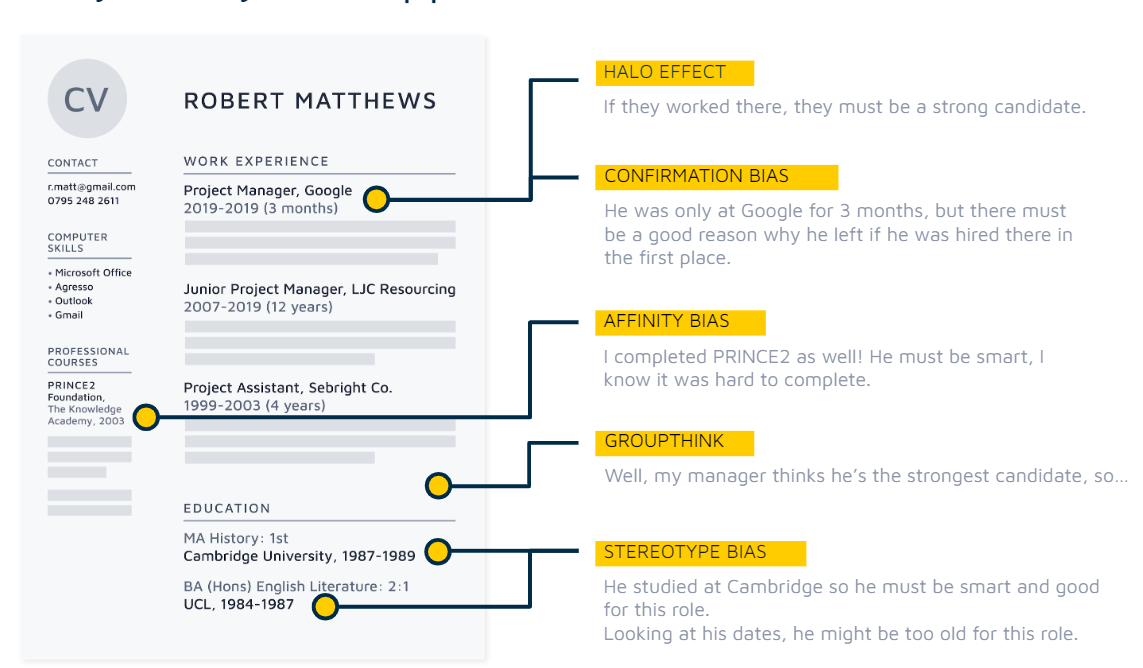
Still not convinced? Well it’s been proven time and time again by what we call correspondence studies (among others). This is where we send thousands of identical CV’s to different organisations and jobs, but just change a couple of key details. In the case of this german study the name and picture (see picture 2)
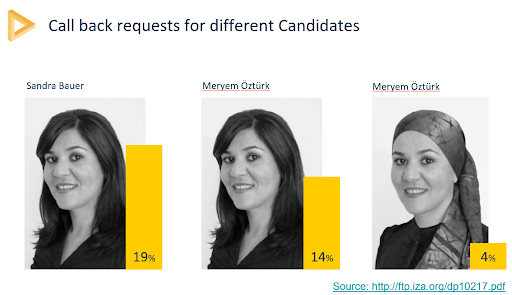
The result was Maryem Ozturk would have to send 40% more applications to get the same number of callbacks as Sandra Bauer despite having an identical CV.
And this isn’t unique. You can see in from the amalgamation of studies below that this is far from geographically isolated or a 1 off (see picture 3)
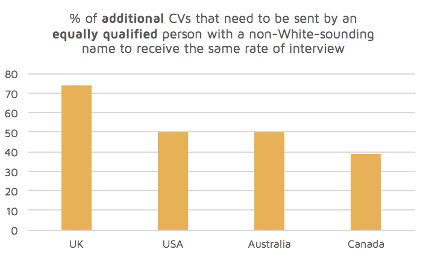
Why we’re looking at the wrong things.
So what is the answer? Unconscious bias training has no measurable impact and can actually make things worse by an effect we call “moral licensing” (you think you can no longer be biased and as a result end up being even more biased).
Instead we need to focus on 2 things that actually do work.
Anonymisation of application
Testing skills directly - not looking for proxies
No 1 should be pretty self explanatory - things that give indication of class, weight, race, gender, attractiveness or any other characteristic that might bias an application should be removed.
No 2 requires a bit more explanation. Typically we have looked at things which are indirect proxies of ability. For example, “You have this degree so we are going to assume you are up to the job” or “You have experience in this job, therefore we will assume you will do well at this other job”. The problem is that although these proxies can be somewhat predictive, you are missing lots of people who might be better, or you might end up hiring someone who isn’t actually great.
Here’s another one of our go-to studies courtesy of Schmidtt & Hunter.
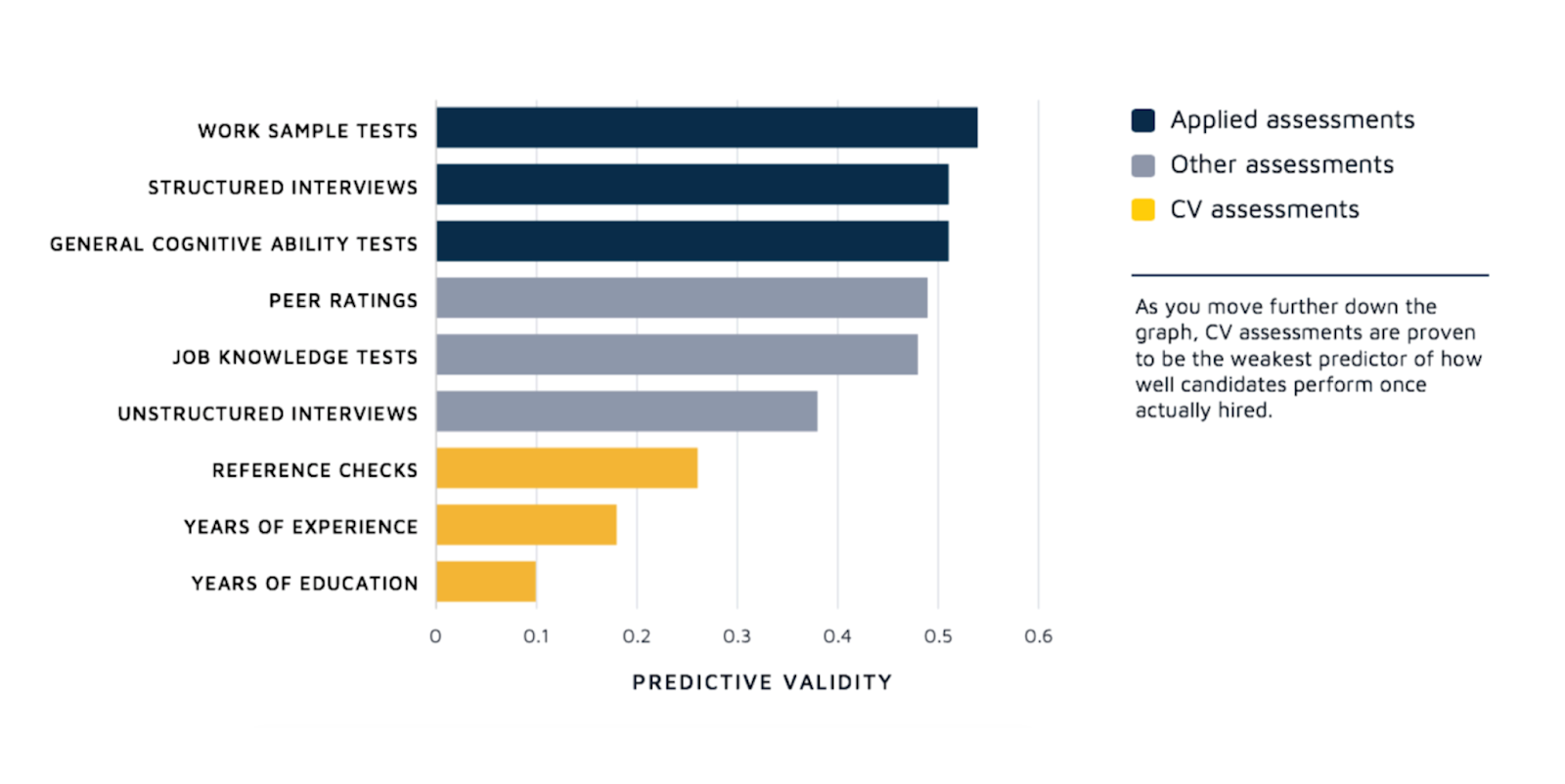 As you can see, work samples are the most predictive assessment method, whilst education and experience performed pretty poorly. Sure, someone’s degree or years of hard-earned experience can (and often do) make them the best person for the job. But instead of just assuming they’re the best based on this alone we need to pull in more predictive measures. The answer is work samples.
As you can see, work samples are the most predictive assessment method, whilst education and experience performed pretty poorly. Sure, someone’s degree or years of hard-earned experience can (and often do) make them the best person for the job. But instead of just assuming they’re the best based on this alone we need to pull in more predictive measures. The answer is work samples.
Work Samples
So what are “work samples”? They are quite simply little simulations of the actual job. Unsurprisingly, the most accurate way to see if someone is good at a job is to get them to do a bit of it.
What these look like depends on the role and level, but well made ones work just as well. For a sales person it might be as simple asking someone to draft a sales email or, for a developer, it would be to get them to write some code.
If you’d like to learn more about creating work samples, check out our guide - https://www.beapplied.com/resources-work-sample-guide
Of the 5000 people who have been hired through our platform (using work samples rather than CV’s) the results are measurable and brilliant. We see first year retention rates (not being fired or quitting) go from 80% → 96%, interview to hire ratio can improve 3x (indicating we’re bringing the right people forward), 60% of those hired would have been missed by a CV screen, and there is a 3-4 increase in non-white hires. This is what happens when bias isn’t messing with your process.
There is a lot more to making a truly unbiased screening process. Getting interviewing right, capturing all the right data and writing the perfect job adverts/job descriptions to say just a little, but scrapping the CV, and anonymisation is a great first step.
We hope this blog helps you to create an unbiased screening process. If you would like to know more about the Applied platform or how we think about recruitment, check out our resources hub, webinars or get a free trial.
Khyati Sundaram, CEO of Applied, was a keynote speaker for our webinar on Driving Diversity. If you want to improve diversity within your organisation, watch the webinar here.
Written by Patrick White, Applied






